-
Posts
1,262 -
Joined
-
Last visited
Content Type
Profiles
Forums
Events
Store
Posts posted by Andrej Stancak
-
-
While it is possible to estimate approximate body heights of people standing close to Mr. Frazier using his known body height and known dimensions of certain facial features, there is an alternative and a more accurate method. It consists in creating an accurate 3D model of the doorway, orienting the doorway to match Darnell's camera view, and reading the body heights from the model.
The figure below shows the inner doorway with five measuring sticks placed on the western wall (2), on the side frames of the glass door (2) and at the front edge of the top landing (1). The height of the doorway is known: it was measured by Bart Kamp in autumn 2017 and Bart was kind enough to share his measurements with me. At that time I was almost abandoning the doorway project being frustrated by seeing inaccuracies in the alignment of my model and Darnell' still which could not be resolved without using hard data. The doorway height is 288 cm or 9'5'' 4/10.
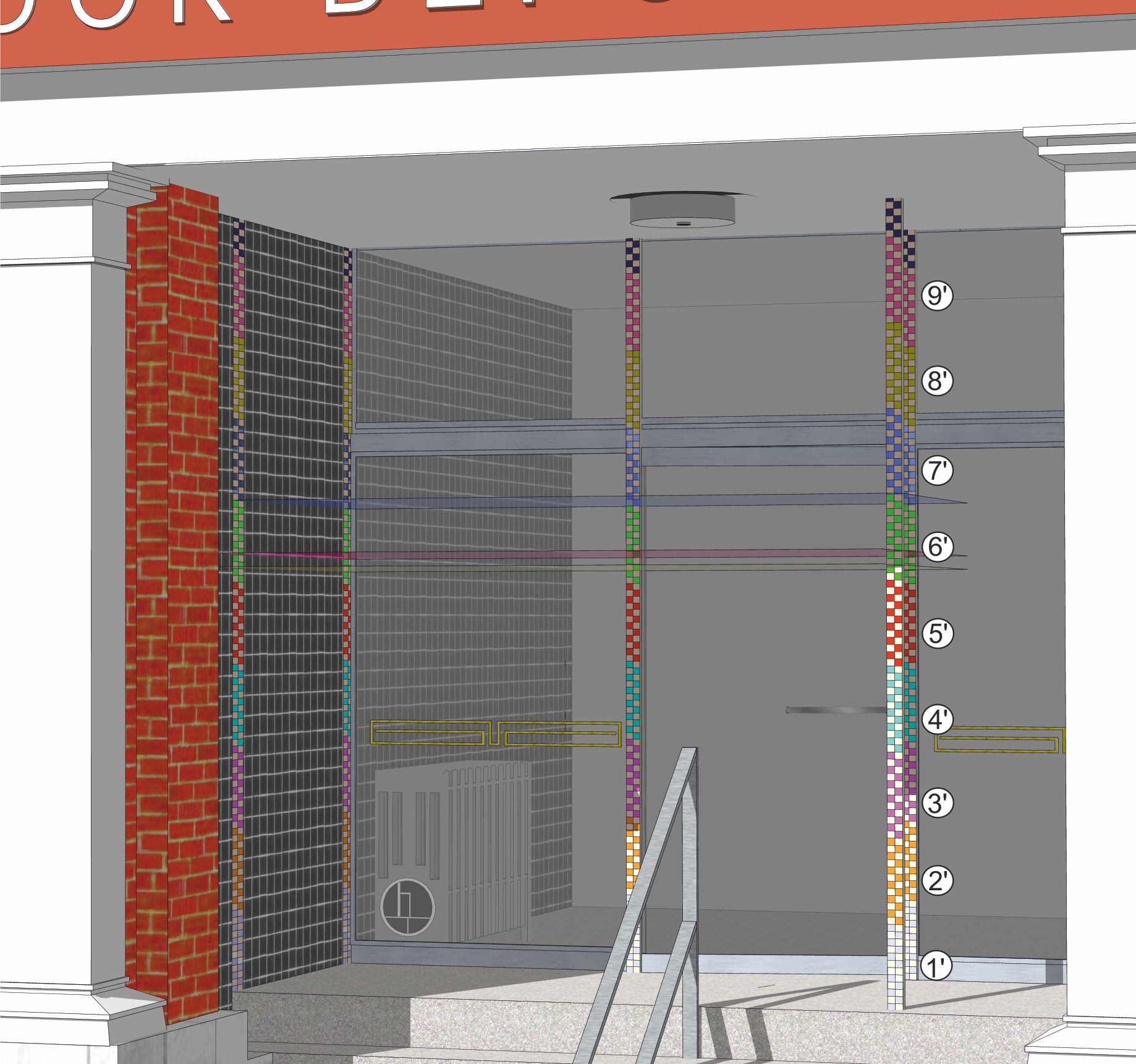
Besides the five measuring sticks, there are also three horizontal planes in the doorway: the blue plane is at the height of 6' which is the known body height of Buell Wesley Frazier. The yellow plane is at 5'2'', the height at which Prayer Man's head appeared above the top landing according to the provisional analysis explained in my last post. The red plane is at 5'4'' which is the lower limit of the range of body heights given by members of Mrs. Stanton's family.
Please check in the figure below the accuracy of how the three planes would cross the measuring sticks.
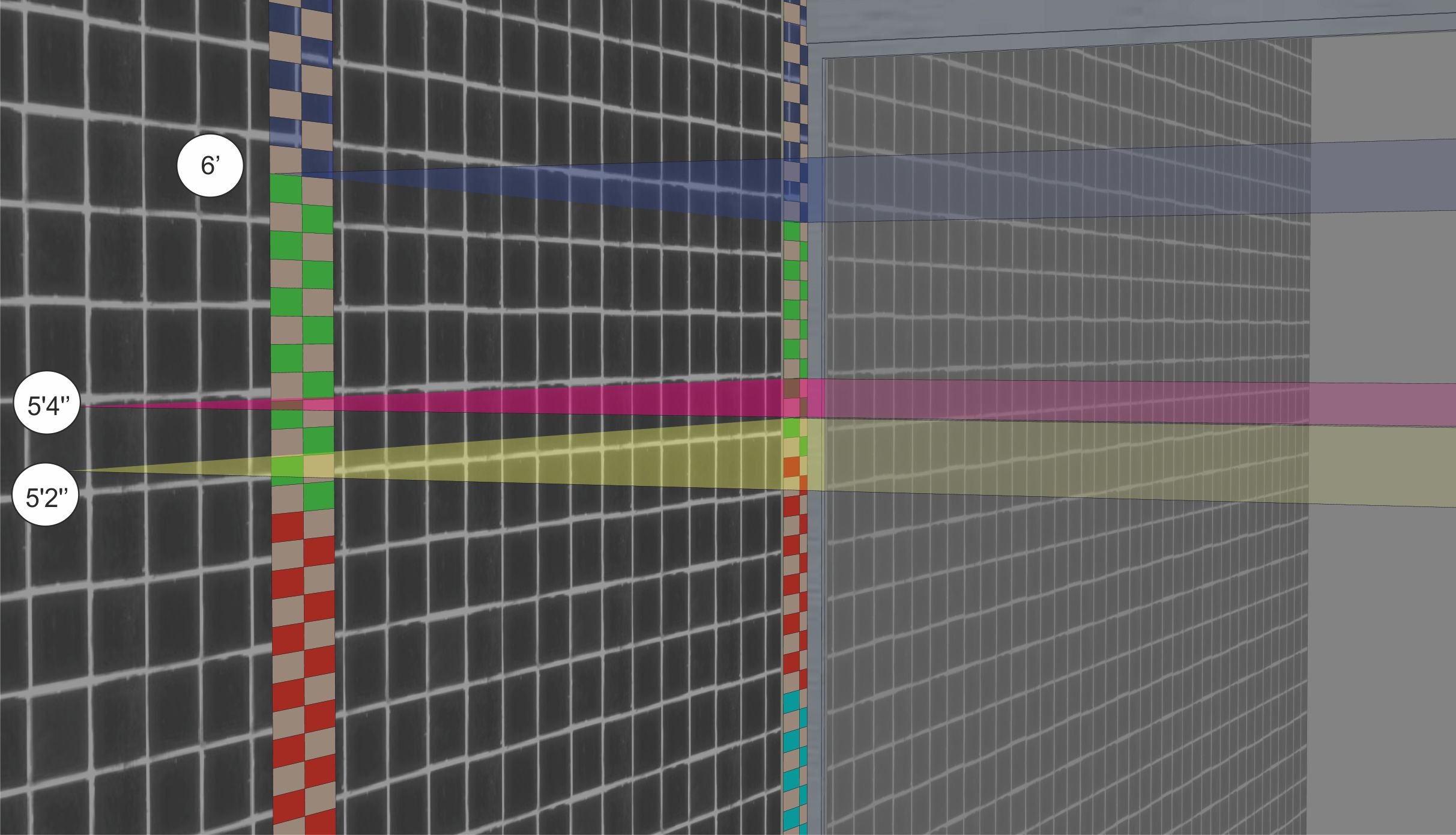
I have delineated Prayer Man's head in Darnell still with a yellow line and copied the 3D model with the three planes and the measuring sticks on board onto Darnell still. The yellow line touches the bottom of the three planes.

Here the same in detail:
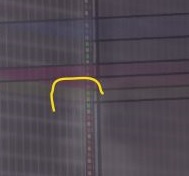
A better method to check which of the planes was touched or crossed by Prayer Man's head is to overlay also Prayer Man's mannequin. The figure below shows the three planes and Prayer Man's and Mr. Frazier's figures at the blending rate of 80% (more of Darnell background seen at this blending ratio). Please note that both Prayer Man's and Mr. Frazier's mannequins match their originals accurately.

And the same with a 65%-percent blending ratio:

The next figure confirms that Mr. Frazier, as depicted in Darnell, was indeed 6' tall. Please note that the red 5'4'' plane would cross Mr. Frazier's mouth and the yellow 5'2'' plane would cross the neck just below his chin.

Finally, the detail of Prayer Man's head.
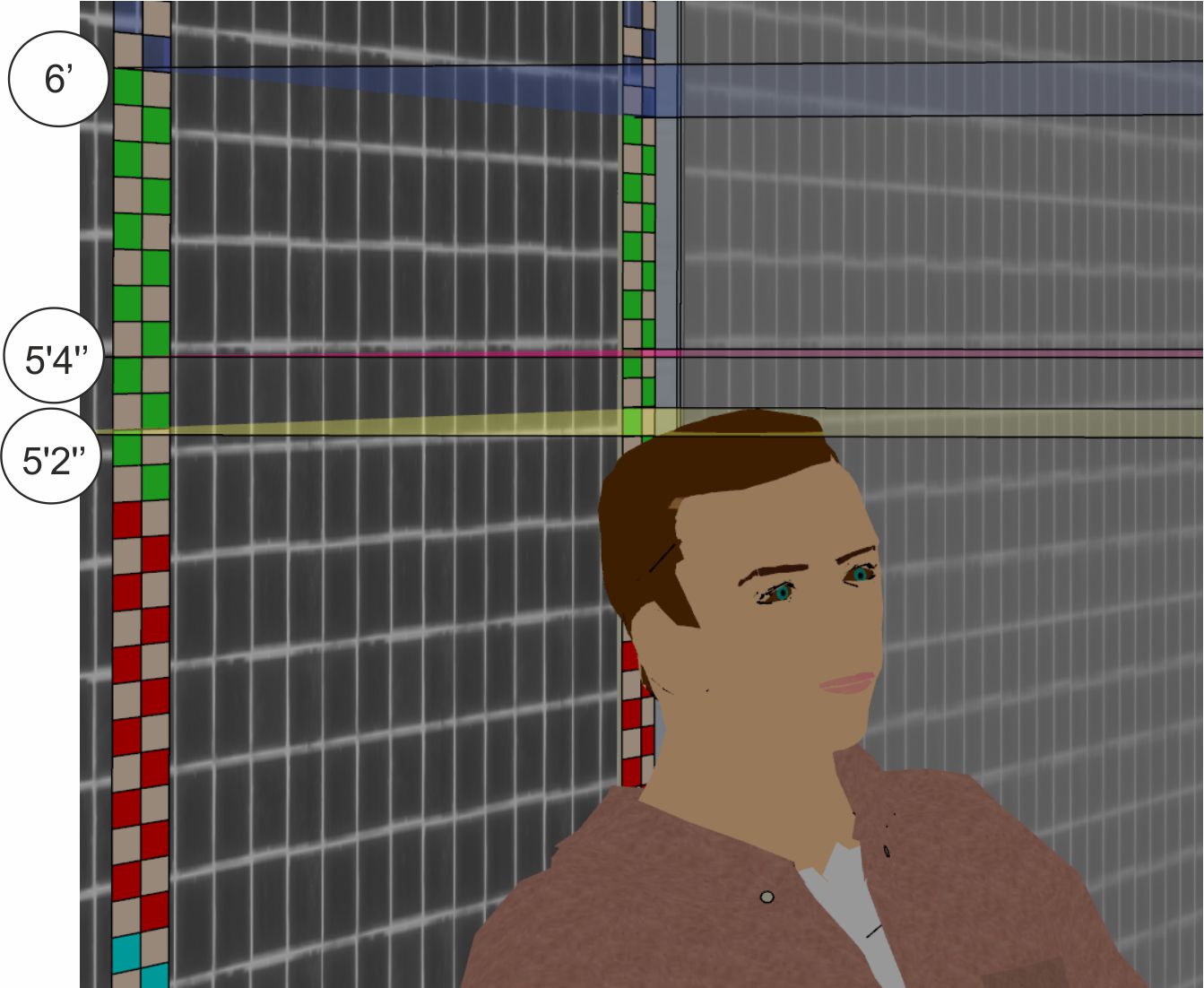
Prayer Man's head crosses the yellow 5'2'' plane with an excess of 1.2 cm (a bit less than 1/2 inch), however, it is far from the red 5'4'' plane. This analysis excludes Mrs. Stanton as Prayer Man as her body height of 5'6'' (or more) was far above what it should be (5'2'' 1/2). It is not only the lack of thick grey hair in Prayer Man's head but also her large body which discards Mrs. Stanton as a Prayer Man candidate.
In contrast, Prayer Man's body height of 5'9'' 1/2 fully conforms with the possibility of Lee Oswald, 5'9'' according to his autopsy report (https://texashistory.unt.edu/ark:/67531/metapth337932/m1/1/) , being Prayer Man. The extra less than half an inch was certainly related to the differences between autopsy-reported body height which was determined on a naked body and the body height captured in a dressed person wearing shoes. This was also the likely reason for seeing Mrs. Stanton's hair about at the height of 5'7'' which exceeds by about 1 inch the upper limit of her body height 5'6'' reported by her family.
Question: would you agree that it is possible to estimate with a high level of certainty Prayer Man's body height?
-
I will post the updated 3D model-based height estimates after fixing some of the figures which I think deserve more care. In the meantime, it is possible to learn about the body heights of different people using Mr. Frazier's body as a measuring stick. Mr. Frazier was 6'0'' or just tiny bit taller (6'1''). As the people of interest (Mr. Shelley, Mrs. Stanton) stood on the same platform as Mr. Frazier and the depth differences were small, the horizontal lines led through the top of heads of Mr. Shelley and Mrs. Stanton inform about their approximate body height.
In the figure below, the horizontal top blue line crosses the top of Mr. Frazier's head and therefore, this provides 6'0 - 6'1'' level relative to the surface of the top landing. The bottom blue line crosses the lower aspect of Mr. Frazier's chin. The dimension (14) in the look-up table below shows that a tall person falling into the top quartile of the male population would have a head sized 10'' or just a tiny bit less. I count 10'' for the sake of simplicity as this is only an approximate method to learn about the body heights of different people in the doorway. This line, incidentally, crosses the top of Prayer Man's head, so his body height could only be 5'2'' if Frazier was 6' or 5'3'' if Frazier was 6'1''.
The top of the grey blob sitting on top of Mr. Shelley's head corresponds to the blue line crossing Mr. Frazier's root of the nose or eyes. The dimension (9) equaling 5'' corresponds to the distance between this blue line and the top of Mr. Frazier's head. 6' - 5'' is 5'7'' and 6'1'' - 5'' is 5'8''. Thus, Mrs. Stanton's body height was 5'7'' (Frazier = 6') or 5'8'' (Frazier = 6'1''). Finally, the line crossing the top of Mr. Shelley's head appears to align with Mr. Frazier subnasale point. To measure the height of this line, we need to subtract the dimensions (14-16) from 6' or 6'1''. This would give 6'- 6' 1/2 = 5'5'' 1/2 (Frazier = 6.0') or 6'1- 6'' 1/2 = 5' 6'' 1/2 (Frazier = 6.1).
The look-up table with facial landmarks and dimensions were reproduced from "Human Head" chapter at wikipedia.org.

-
Paul:
you raised important questions. Mr. Frazier referred to "Sarah" on a few occasions, so he indeed knew her quite well. However, this clear confirmation of Mrs. Stanton's location to his left is only in this interview.
The body height of Mr. Frazier has never been confirmed unequivocally. However, Robert Prudhomme, the researcher who started this very thread, was able to retrieve information from a newsman who knew Mr. Shelley. There is even a thread on this Forum on Mr. Shelley's body height:
Bob Prudhomme contacted Mr. Shelley's son to learn about his father's body height, however, he received no reply. Instead, Mr. Prudhomme received a letter from a journalist who knew Bill Shelley. This letter was posted by Mr. Prudhomme on Deep Politics Forum on February 24, 2017. This is the copy-paste of the letter:
"Dear Mr. Prudhomme:
Your question about Bill Shelley's height is difficult to answer. At the time I met Shelley in the early 1970's, he was perhaps 5-5 or 5-6. However, he told an employee (TSBD employee?) he was once two inches taller. According to the employee, Shelley claimed he broke his back in a car accident sometime after the JFK assassination. Subsequent surgery supposedly left him two inches shorter. Shelley never mentioned the car accident in my presence, but the employee was a reliable source and Shelley's claim would have been plausible. Moreover, I recall Shelley was slightly misshaped as if he had indeed lost a couple of inches of height above the hips.
For the sake of clarity, I met Shelley while he was working at the Scott Foresman school book warehouse in Northwest Dallas. This was the new home of the old Texas School Book Depository. As for Shelley, after reading his Warren Commission testimony years later I realized I had learned little new information about him. Perhaps my biggest takeaway from the experience was a strong suspicion the Texas School Book Depository was a storefront for domestic intelligence. After the assassination, the storefront may have been moved to the new Scott Foresman warehouse in Northwest Dallas.
Hope this information sheds a little light for you. Very best of luck.
Sincerely,
**** *****
Austin, Texas"My estimate of Bill Shelley's body height is 5'5'' or a tiny bit shorter. The body height of 5'5'' would be consistent with the information contained in the letter above. I will post some more data on Shelley's body height shortly.
-
As pointed out by several astute researchers before me, Mr. Buell Wesley Frazier commented on the location of a lady who worked in a Depository office in his interview for the Sixth Floor Museum on June 21, 2002. When asked by the interviewer, Mr. Gary Mack, if the lady stood to his left or right, Mr. Frazier replied at an instant that the lady stood to his left. His verbal response was accompanied by turning briefly his gaze leftward and pointing with his left hand toward his left. The frames below were selected from stills starting 53'33'. To Mr. Frazier's left means in the direction of where Mr. Shelley stood.

-
Michael:
Sarah Stanton was tall, around 5'6'' according to information provided by surviving members of her family. She was also obese (300+ pounds) and had a specific grey hair. The family photograph in my last post, obtained from Mrs. Stanton's family by Mr. Doyle last June, shows her with her son Larry. Larry himself was very tall, at least 6' or 6'1'' which is practically the same height as Buell Wesley Frazier's body height. In that family photograph, the top of Mrs. Stanton's head reaches to about half of Larry's notes. Simple math based on known relationships among face features tells us that Mrs. Stanton was indeed at least 5'6'' as her family members also pointed out.
In the figure below, the rectangle in (A) defines the critical area of Darnell doorway. In B, the grey blob is highlighted with yellow line and Mr. Shelley's face and hair with blue lines. In (D), if you draw a horizontal line connecting the top of the grey blob and Mr. Frazier's face, you may see that the grey spot which I believe was Mrs. Stanton's hair was about the root of Mr. Frazier's nose. It is a bit uncertain where exactly the line should be drawn given the blurriness of both the grey blob and Mr. Frazier's face, yet it is clear that the grey blob is where it would be expected if it belonged Mrs. Stanton. For instance, the line certainly did not cross Mr. Frazier's chin or mouth which would exclude this grey blob as Mrs. Stanton's hair. The 3D contour plots in my last post illustrate the presence of two people in the spot covered by the orange rectangle in (A) much better than the figure below. Humans understand that there is a gradient in blobs of certain grey level, however, we cannot reconstruct in our minds the spatial information which the grading of grey contains.

-
You may wonder why I continue posting if no one joints the debate. There are a few points I would like to share with the Forum, so please bear with me before completing my posting in this thread. Prayer Man's identity is the most important problem of all in the JFK assassination case – there is no clearer and more absolute refutation of the official version of events than Lee Oswald standing in the doorway for a brief period of time just after the last shot. If he was in the doorway during the time of Wiegman and Darnell films, he could not be the President's assassin. If Lee Oswald were Prayer Man, all that happened to him, the whole investigation, the conclusion of two governmental commissions, and the whole 55 years of reporting about JFK assassination by the mainstream media would be questioned without any chance of a comeback. I wish that anyone who in future stumbles on Prayer Man can find data which cannot be found in archives or be copied from books or various forums. There is no height tag on Prayer Man’s forehead which would say how tall this person was. Yet, the doorway is a physical object with known dimensions and therefore, it is possible to determine Prayer Man’s body height very accurately by reconstructing the doorway (in a 3D model) and reading the height to which the top of Prayer Man reaches. There are more delicate problems, such as what was Prayer Man’s posture and where exactly did he stand, what clothes did he wear, when did he enter the doorway and when did he leave it. Whoever is seriously interested in the identity of Prayer Man would need to address at least some of these questions.
Today I would like to look at the whereabouts of Mrs. Stanton in Darnell film. If we say that Prayer Man was most likely Lee Oswald then we also need to offer a plausible explanation of where the other Prayer Man candidate stood. That other candidate is Mrs. Sarah Stanton.
To recall: Mr. Frazier stood close to the glass door in the western part of the doorway in Altgens6 and this is the reason for not seeing him in this picture. However, his faint figure is visible in Wiegman after giving it some work, and possibly in Hughes, and therefore it can be taken for granted that he indeed stood on the top landing during and after the shooting. Of course, he is in plain sight in Darnell.
Mr. Shelley is the man in a dark suit, wearing a white shirt and a dark tie in Altgens. He stood at a premium post in the centre of the top landing, and he is seen at this spot also in Wiegman. This man remained at his spot also in Darnell. Mr. Shelley confirmed in his Warren Commission testimony that for about a minute after the last shot he did not do anything, he remained at the place where he was during the shooting.
Mrs. Sanders stood in the eastern part of the doorway and close to the glass door. She can be seen in only one frame of Darnell, fortunately, her body height and unique shape of her hair prove that it was her.
And then there was also Mrs. Stanton who stood on the top landing. Mrs. Stanton was a huge lady weighing 300 pounds and measuring 5’6’’, not a minor at all. She also had a thick grey hair which would require us to see a grey strip about at the height of 5’6’’ somewhere in the doorway. As no one has identified Mrs. Stanton in the doorway for more than 55 years, maybe that was the reason to consider Mrs. Stanton to be Prayer Man. While it is easy to refute Mrs. Stanton as Prayer Man (where is the grey strip of her hair on Prayer Man’s head, please?), it also poses a challenge for those who consider Lee Oswald as being Prayer Man to find her. Until there is a human figure in the doorway matching the height of about 5’6’’ and displaying a grey strip at that height, there always be a nagging uncertainty of Sarah Stanton perhaps being Prayer Man.
So, let us find her. Actually, I did some work on Sarah Stanton in my blog http://thejfktruthmatters.wordpress.com (January 31, 2018), and found a faint shape of a person standing behind Mr. Shelley’s right shoulder.
The figure below shows the critical area of Darnell's doorway where I believe Mrs. Stanton can be found. Well, where else? She is not seen anywhere in the eastern part of the doorway, she is not hidden behind Mr. Frazier, and she is not Prayer Man ("where is the grey strip? question, plus she with her 5'6'' would be too tall to be Prayer Man as the top of his head reaches only to 5'2'' above the top landing). I hope to convince you that there were three people standing in front of each other and that the person in the back was Mrs. Stanton.
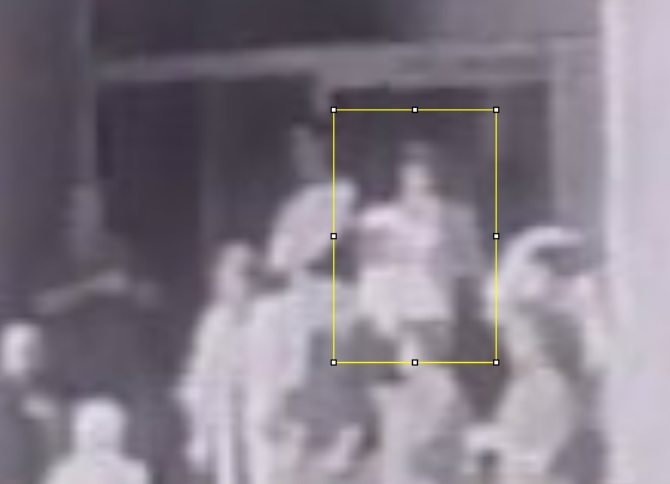
First, the continuity of some people's locations in the doorway. I reason that if some people were consistently seen at specific locations in Altgens6 and Wiegman and Darnell , had the same clothes and showed the same or similar gestures, they most likely were the same persons who were captured by three different photographers.
The next figure shows the mapping of doorway occupants in Altgens6, Wiegman, and Darnell. The yellow line connects Mr. Shelley's figures, the green line connects Mr. Molina and the purple line is for Mr. Williams.
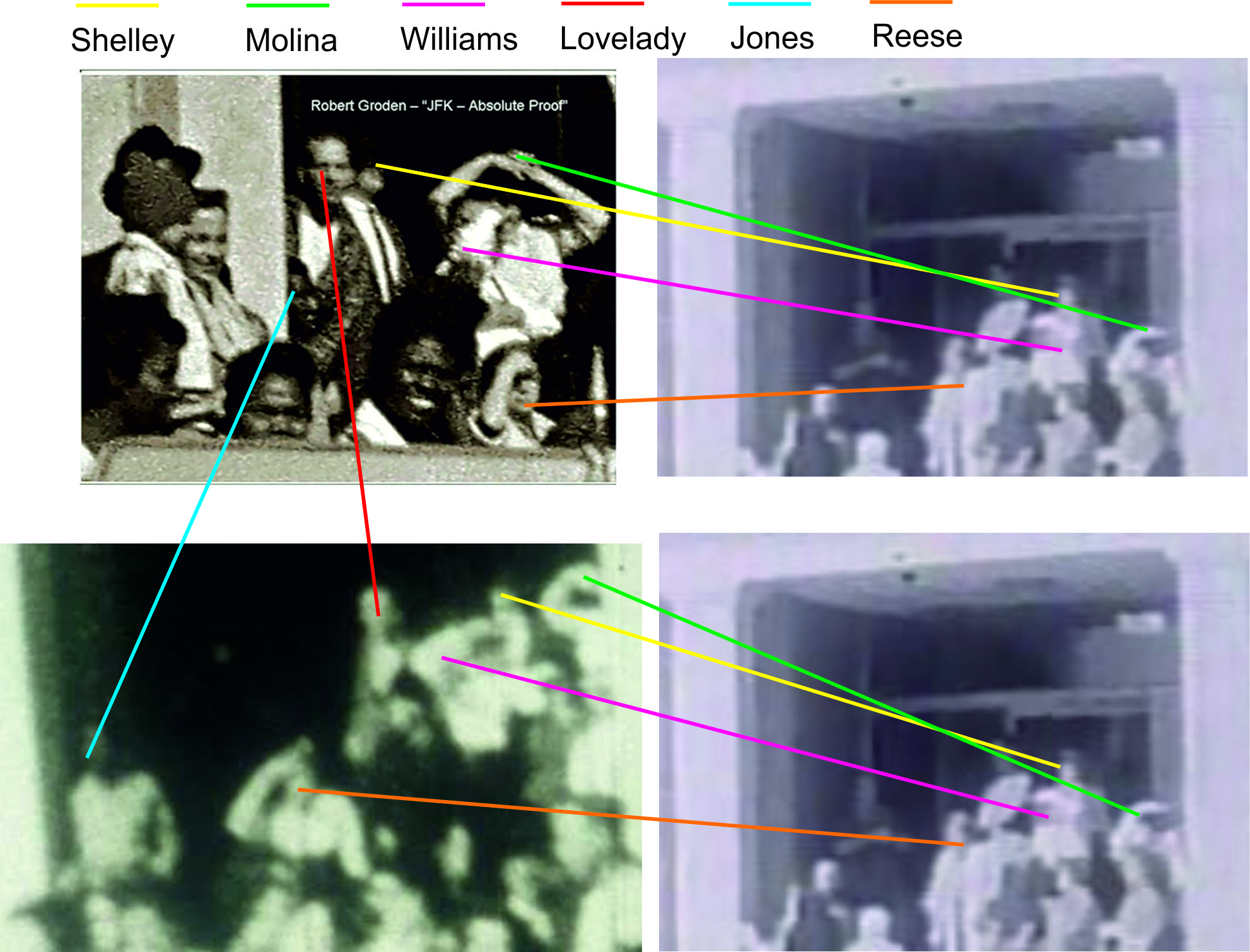
So, the yellow rectangle of interest in Darnell contains Mr. Williams in the first line, Mr. Shelley behind him, and another person which stands behind Mr. Shelley from whom we only see a grey strip. To recall, Mrs. Stanton was a huge lady (5'6'') with thick grey hair. Mr. Shelley had a dark hair, and his dark hair is seen as a comparatively thin dark band above the bright ellipse of his head. He could not have his dark hair and another strip of grey hair on top.
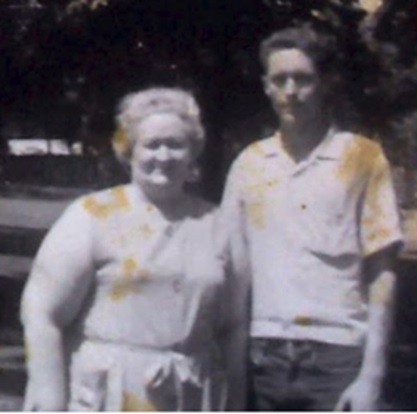
The figure below is a reconstruction of the three figures using the 3D surface plot in ImageJ program. The program resolves the gradient within the blobs of seemingly equal shades of grey which our eyes are not capable to arrange as depth gradients. Yet, objects in the doorways were spatially arranged and did not receive the same amount of light. Typically, objects in the back of the doorway would be in the shadow while those at the level of e.g., second step would be fully illuminated by sunlight.
In the figure below, the part of Darnell in the yellow rectangle clearly disentangles three people. The person painted in white is the one shielding his eyes with his left arm. It would be Mr. Williams. His head is not seen because it was wrapped up by the white arm (long sleeve). Below Mr. Williams is the figure in yellow-red with a white spot on his left chest - this would be Mr. Shelley. Please note that there is a hole painted with dark red at the place where are Mr. Shelley's dark hair: anything dark will sink, and anything bright will be extruded in this type of analysis. And here comes the third person, painted in blue and purple. The purple spot represents the front part of this person's hair. This person is taller than Mr. Shelley and stood behind Mr. Shelley.
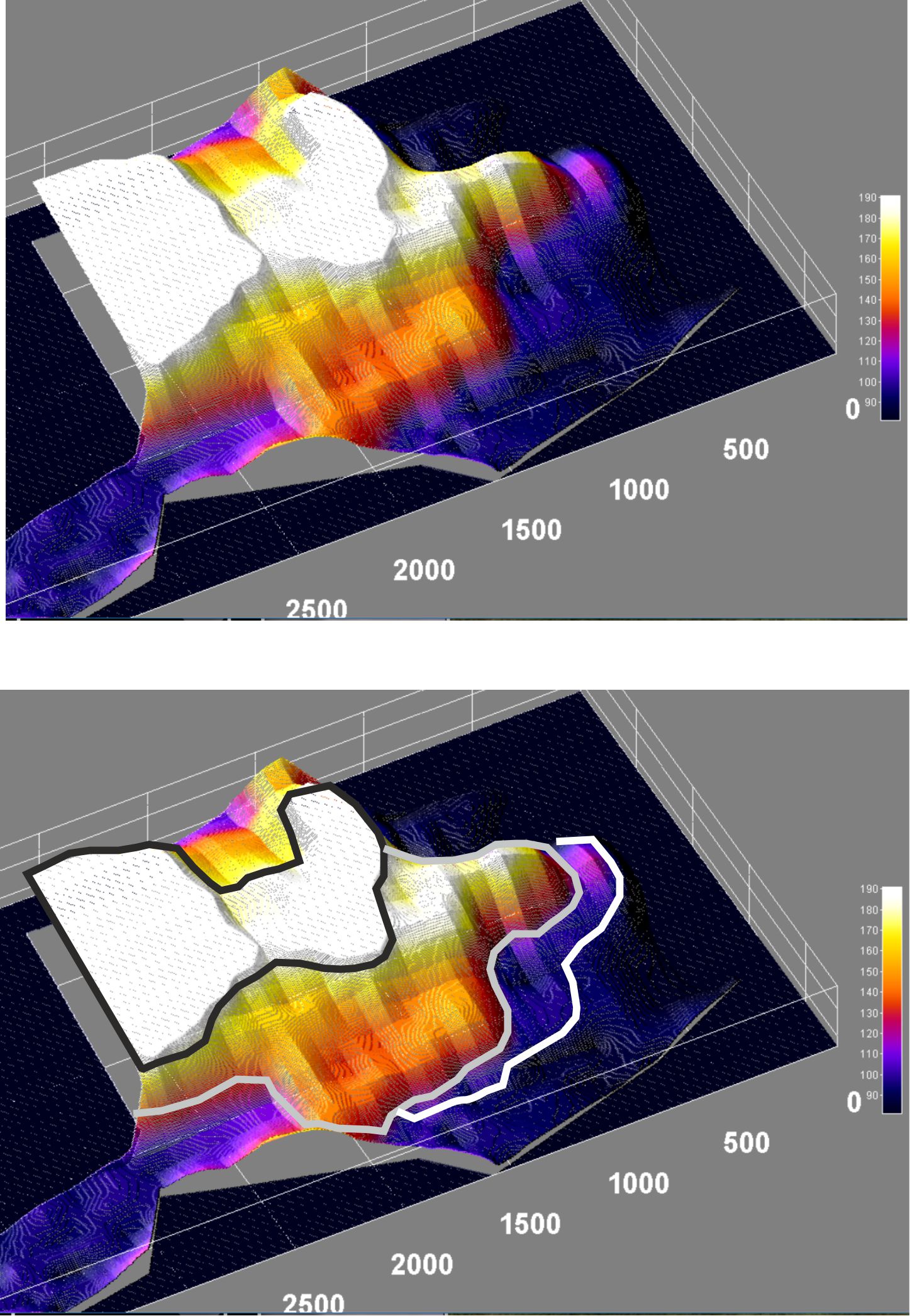
The next figure is the front view of the region of interest in Darnell still. The separation between the top of Mr. Shelley's head and the brighter blob (the grey strip in Darnell) is clearly visible and proves the presence of another person behind Mr. Shelley. It is possible that the person in the background was looking toward the triple underpass through the space above Mr. Shelley's right shoulder.

Question: do you agree that there was a person with grey hair, taller than Mr. Shelley and standing behind him?
If my analysis convinced you and you can answer affirmatively that there was a person in the back of the doorway from whom we see her grey hair in Darnell, it is maybe easy to answer the follow-up question, namely who was this person. Well, it could only be Mrs. Stanton because there is no other candidate remaining. The doorway scene changed little over about 30 seconds (actually less than 30 seconds) elapsing between Wiegman and Darnell films. Mrs. Stanton, in my opinion, can be evidenced in Altgens6 in the space behind Mr. Lovelady (who stood on the second step) and Mr. Shelley. She was leaning through that space and a part of her face and hair emerged in the space between Mr. Lovelady and Mr. Shelley. The space on the top landing behind Mr. Lovelady was later taken by Buell Wesley Frazier and this was only possible because Mrs. Stanton slid back behind Mr. Shelley.
Here is the bright oval shape next to Lovelady's left cheek which for some reason remained unnoticed for some 55 years:

-
In the coloured relief of Prayer Man showed in my last post, his shirt shows distinct spots which are deeper (darker) than the neighboring areas. Any aspect of this man's shirt which is dark will be as if pressed into the shirt and any aspects which is light, e.g. a button, will be pulled out.
If this man in the doorway was Lee Oswald, he would wear a reddish shirt CE151. CE151 was Lee's work shirt. He had it on himself while working in the Depository on Thursday, November 21, and since he traveled with Buell Wesley Frazier to Irving without stopping at his rooming house to change his shirt, he also wore that same reddish shirt on Friday morning, November 22. So, Lee had a shirt on him in which he was lifting book boxes, placed them on a trolley, and moved the trolleys for packing to the first floor. As he has been lifting dusty boxes with black print on them very often, the book boxes have left dirty spots on his shirt. The dirty spots on CE151 were not distributed randomly, rather they were distributed diagonally along an approximate axis running from the left hip to the right chest. Here is how a dusty box would leave a diagonally distributed spots on a shirt.
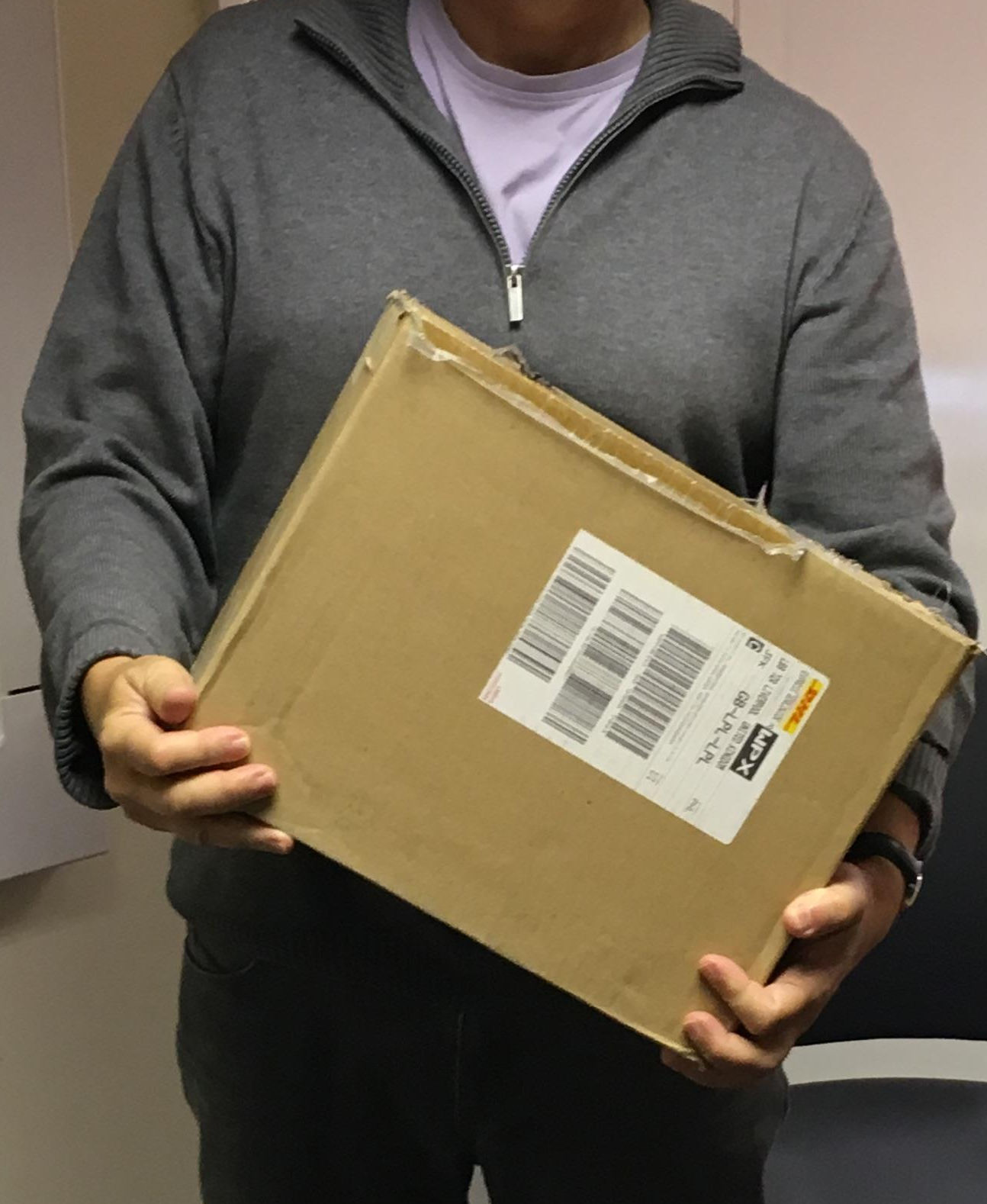
The next figure shows the reddish shirt CE151 which was obtained from the NARA by Pat Speer in 2016 (top left). The picture is of very good quality and it is, therefore, possible to inspect the distribution of dirty spots on the front facing of the shirt. The right-hand top panel shows the enhanced shirt with the dark spots clearly visible. The dirty spots were arranged in a diagonal fashion as expected if the shirt was worn by Lee Oswald, the order filler in a book warehouse.
The bottom left panel shows the result of the 3D contour analysis with the shirt CE151. The dark spots are clearly visible and can be compared with the shirt worn by Lee Oswald. The dark spots on Prayer Man's shirt are shown in the bottom right panel. The greenish lines delineate concave (inward) regions on the shirt and the two light circles identify local convexities (outward). A diagonal arrangement of the dark spots on Prayer Man's shirt is present and bears similarity arrangement of dark spots on CE151. CE151 in the NARA photograph is spread differently compared to when it is worn and the flat shirt cannot be exactly matched to the orientation of Prayer Man's torso.
I would be grateful for any opinion on whether the dark spots seen in Prayer Man's shirt would be similar to the spots seen in CE151. If there was a diagonal arrangement of dark spots on Prayer Man's shirt, it provides an unusually strong circumstantial evidence in favor of Lee being Prayer Man. How on earth could a random person's shirt show dark spots where CE151 shows them just by chance?

To check the inwardly and outwardly orientated patches on Prayer Man's shirt, please see the larger plot in my previous post.
-
On 9/24/2015 at 5:00 PM, Robert Howard said:
Colorization....I know enough about the technology to realize cinematographers will colorize B&W films, using actual color photos of a certain area or event. Does anyone else think this is a applicable area. If so or even if not, I would be curious to see what people think.
This one is for Robert because he was genuinely interested. It shows the relief based on 3D contours - things that are bright are pulled out and those which are dark are deep in the picture. The relief has been colourised using a spectrum heat map for a better view of what was forward and/or bright. The part which could be the left knee is on the bright side - I assume that this was because Prayer Man had his left leg ben in the knee joint.
As a bonus, it is possible to identify the contours of Prayer Man's torso which was difficult to do just by viewing the original picture because the boundaries between the body contours and the background are smeared. Prayer Man certainly was not obese - he was actually a lean person given that he was 5'9''. I wonder why then some researchers see Prayer Man as an obese person having thick grey hair. The hair in the picture below would be extruded substantially if this person had light grey hair.
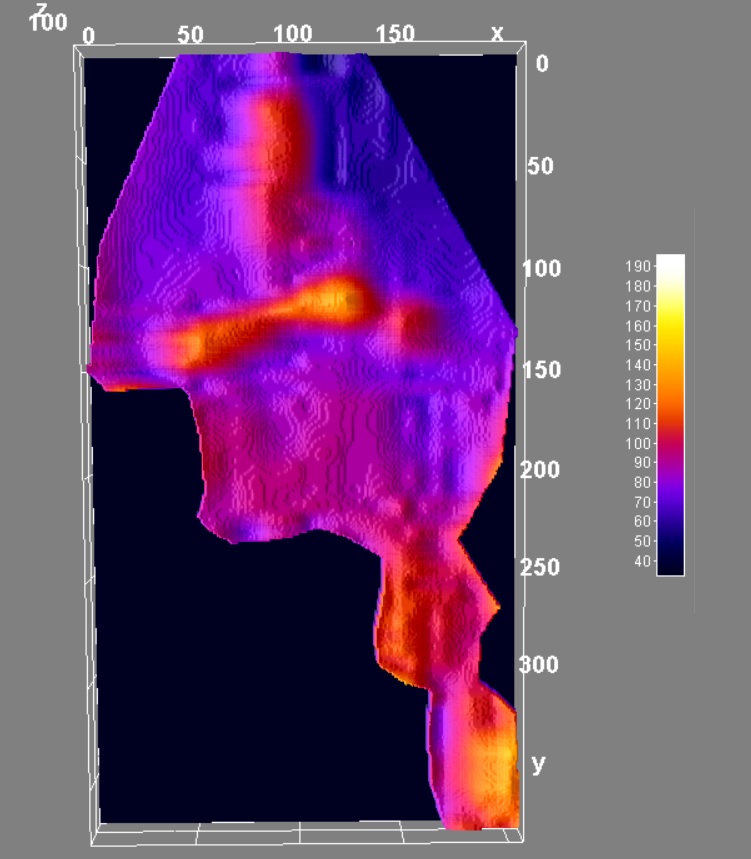
-
-
There is actually a thread on this Forum discussing the similarity between Bill Shelley and the man standing in the leafletting group in New Orleans, 1963:
real evidence (for a change) – what is it with these pictures of Oswald leafletting? by Martin Bank, November 7, 2015.
Larry Hancock in that thread suggested that the man resembling Shelley was actually one Thomas Beckham.

-
A better view of Prayer Man's left leg is offered in frames in which the lady in white is still not on steps. The stills from that portion of Darnell film are blurry, yet they offer a view of both Prayer Man's body and a piece of the white radiator next to Prayer Man's bent left leg. The figure below shows the still chosen for the surface analysis, the section of the doorway with Prayer Man and a white cubic object next to his left leg, and the 3D surface reconstruction. The left leg is clearly bent and the shape of the contour of the left leg is depicted with the purple line below. If you would struggle to identify Prayer Man in the surface plot, he is in the supine position with legs pointing rightwards.
The importance of this finding is obvious: if Prayer Man stood with his right leg on the second step, the left leg had to be bent in the knee joint which is what the 3D surface analysis shows.
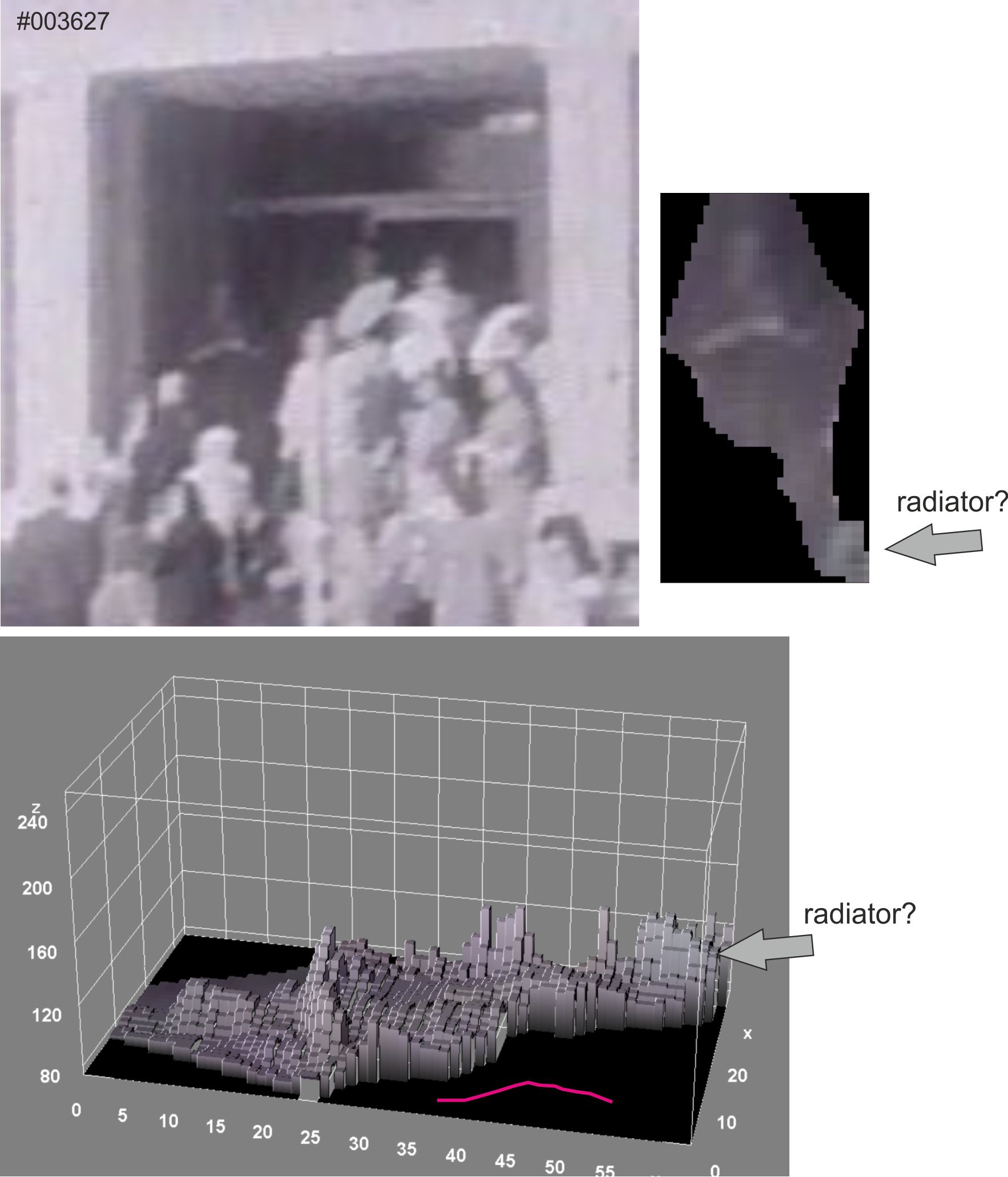
-
This is a 3D surface plot from a section of original Darnell still. It is a bit coarse due to poor resolution of the original image, however, it provides a bit better view in the region of Prayer Man's left leg.
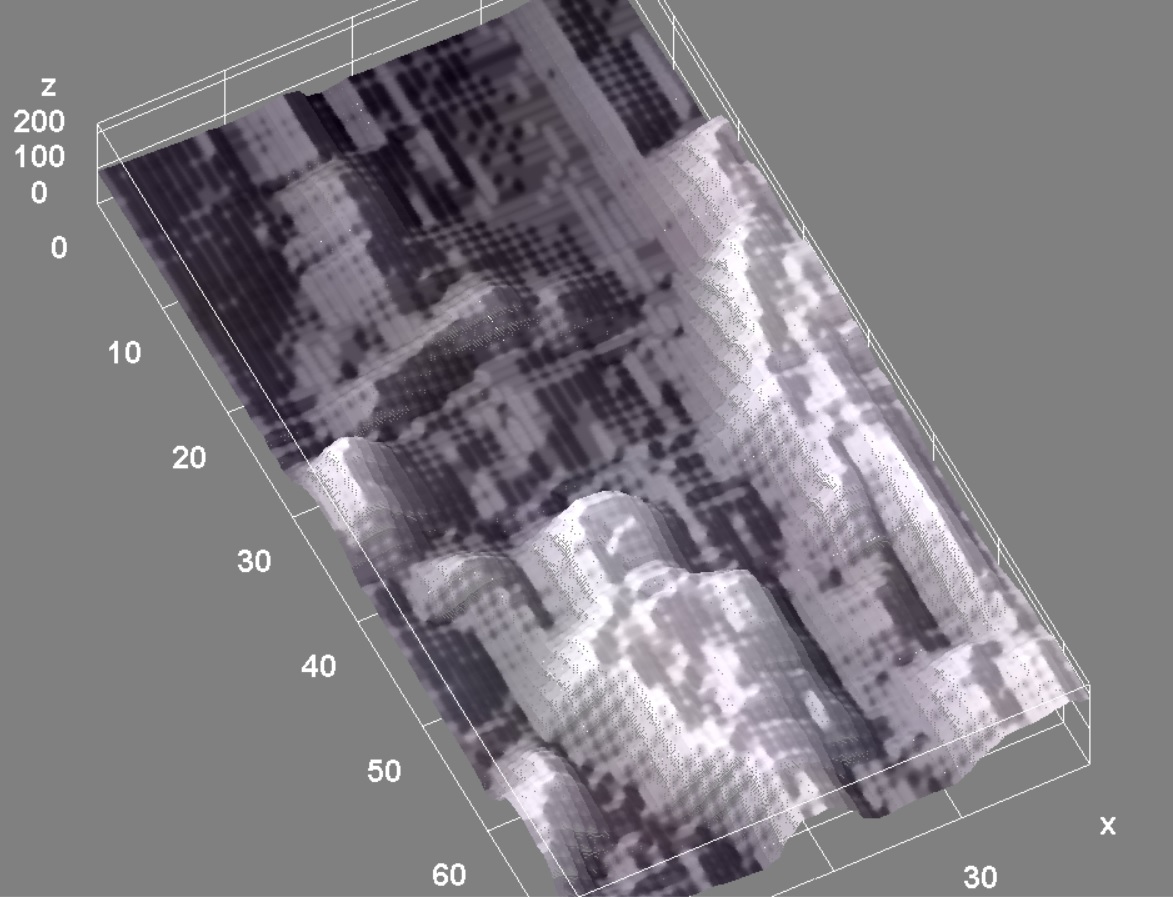
-
This can be a decent Prayer Man thread to continue the debate on one of the most exciting aspects of the JFK assassination case.
This is a 3D surface plot of original Darnell still (left) after resizing it to 300 dpi. The middle panel is the 3D surface plot in which light tones are pulled out and dark tones are deep in the plot. This image was constructed using free ImageJ program. This image analysis method is similar to the one applied to the shroud of Turin. It is refreshing to view Prayer Man from a bit different 3D perspective. Of course, the information which can be extracted still depends on the quality of the original image. Yet, the volume of Prayer Man's body can be appreciated better. In the right panel, I have emphasised with yellow line something which could be the bottom of the bottle, however, it is tentative. In contrast, the area over what I believe is Prayer Man's left thigh is clearly extruded (meaning it is brighter than the rest of Prayer Man's body) which suggests that Prayer Man had his left leg bent.
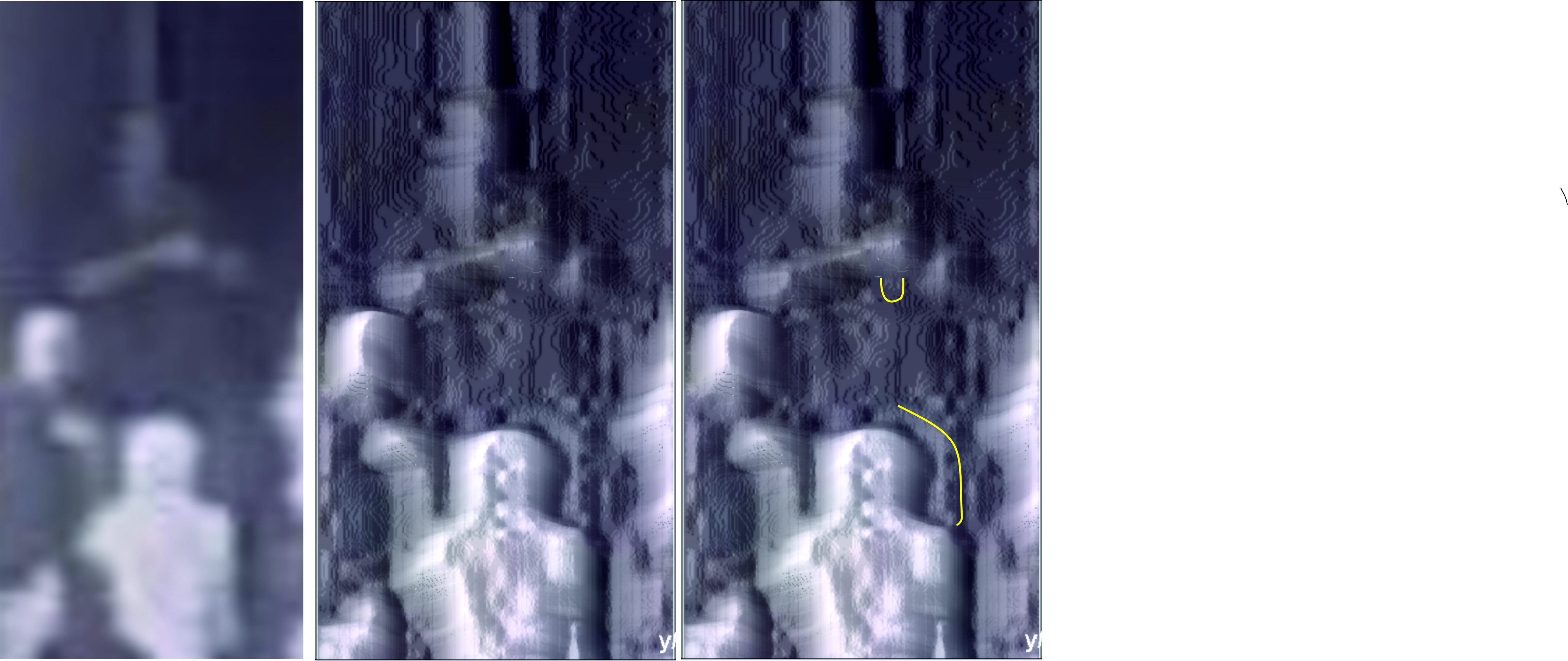
-
I donated $20 soon after James first mentioned problems with our subscription to Invision, and am ready to donate again. Will the Forum be all right if we donate around $40/year per member?
-
Let us keep the Forum alive with our subs. I see no reason why James should bear the costs for our debates. Besides, we are responsible for maintaining the legacy of outstanding researchers who started this off. The wealth of information contained in hundreds of threads is something rare and precious. Of course, there were also many weird pots over the years, e.g., mine, however, it has been a great ride anyway.
-
Denis:
This is from Mrs. Hine's testimony for the Warren Commission:
Miss HINE. Yes, sir; but there is a door before the steps and the elevator is to my left and I went past the hall that goes to my right and I knocked on the door of Lyons and Carnahan; that's a publishing company.
Mr. BALL. What did you do then?
Miss HINE. I tried the door, sir, and it was locked and I couldn't get in and I called, "Me, please let me in," because she's the girl that had that office, Mrs. Lee Watley, and she didn't answer. I don't know if she was there or not, then I left her door. I retraced my steps back to where the hall turns to my left and went down it to Southwestern Publishing Co.'s door and I tried their door and the reason for this was because those windows face out.
Mr. BALL. On to Elm?
Miss HINE. Yes; and on to the triple underpass.
Mr. BALL. I See.
Miss HINE. And there was a girl in there talking on the telephone and I could hear her but she didn't answer the door.
Mr. BALL. Was the door locked?
Miss HINE. Yes, sir.
Mr. BALL. That was which company?
Miss HINE. Southwestern Publishing Co.
Mr. BALL. Did you call to her?
Miss HINE. I called and called and shook the door and she didn't answer me because she was talking on the telephone; I could hear her. They have a little curtain up and I could see her form through the curtains. I could see her talking and I knew that's what she was doing and then I turned and went through the back hall and came through the back door.I read this testimony that there were women in Lyons and Carnahan and Southwestern Publishing, one in each of these two offices. I am not sure about the reasons why the offices were locked. I do not know how many seconds after the last shot it took Mr. Hine to knock on the first of the two offices (10-15 seconds?), however, the phone lines were on during the shooting as one of the office ladies already was on the phone, and she was having the call for some time already (she was not e.g., attempting to dial).
Apparently, there is also a CT theory that the 2nd-floor offices served as a logistics centre of the assassination plot, however, I could not find any solid sources in support of this theory.
That said, I guess the content of the window is blurry and what I see in those shapes may not be what other people see. Perhaps a better version of Darnell will shed some more light on that window too.
-
I wonder if Darnell film shows real humans in the second-floor window just two windows to the west from the main entrance. We know from Mrs. Hine's testimony that at least one person was locked in each of two of the second-floor offices having views on Dealey Plaza, and here one Darnell still appears to show maybe two people in one of the second-floor windows. The figure below shows a cropped view of the second-floor windows in Darnell still in the top panel and enhanced views of the window (red rectangle) in the bottom panel. The right-hand side picture in the bottom panel is my interpretation: I see one female having naked forearms crossed in front of her chest and resting low, maybe on the window ledge or a desk. However, there are two distinct bright circles above her head as if there was another person standing behind her and viewing through a binocular. The woman is delineated with a yellow line and the person with binocular standing further in the back is highlighted with a purple line. My pareidolia?

-
17 minutes ago, Jim Hargrove said:
Still sticking with the opinions, eh? Why don't you share with us your theory of how the sixth floor assassins came down unseen and unheard.
And, by the way, this is just a theory, as John has been clear about from the beginning: From the article:
Passenger elevator
The purpose of this essay is not to "prove" how two men vanished from the 6th floor. My purpose is to show researchers that there is at least one alternative "escape route." By using one plausible "escape route," which I will explain, we may be able to understand the reason why the electricity was briefly turned off, why the 3 men on the 5th floor heard nobody run across the 6th floor to the stairway, why neither the 3 men on the 5th floor (Jarman, Williams, Norman) or the lady office workers on the 4th floor (Styles, Adams) saw anybody running down the stairway or riding the freight elevators, and why Officer Baker and Roy Truly saw nobody on the freight elevators or stairway. What follows is an alternate, and very discreet and secret way by which to go from the 6th floor to the 1st floor. I BELIEVE THE 2 MEN ON THE 6TH FLOOR USED THE PASSENGER ELEVATOR.Jim:
I also take John's article as a theory, and I take it seriously and believe John has also meant it seriously. If it is a serious theory of how assassins escaped from the sixth floor, it needs to be examined and checked from every angle to see if it holds or not. This is what we are doing in this thread because you presented and defended this theory on John's behalf. My analysis, and I spent time both reading John's article and testing various aspects of his theory, says that this theory is not plausible. I gave you my reasons.
As far as my explanation of the escape is concerned, I do not have any at the moment but will present it here once I have any.
-
Jim:
sticking with the untenable lift escape theory discredits the whole of John Armstrong's work. Calling off this incredible theory may salvage the rest of John's work.
-
2 hours ago, Jim Hargrove said:
Thanks, Andrej, but I don’t see how this proves Miss Hine believed Stanton and the others were back as fast as you say. Read Hine’s testimony before the part you quoted. Those other office doors she knocked on and tried to enter, the last one being Southwestern Publishing, where she “called and called and shook the door,” and heard a woman talking on the phone. And then…. “I went straight up to the desk because the telephones were beginning to wink; outside calls were beginning to come in.”
At that point, the electricity, at least in the recently renovated part of the building (offices on floors 2, 3, 4, and the front passenger elevator) had been turned back on. Only after that does she talk about the people who came back in from the street.
My about two-minute time estimate for Mrs. Stanton's return is realistic, and it would allow Mrs. Hine to go round the 2nd-floor offices and return to her workplace. However, the point and a major problem for John Armstrong's escape theory is that Mrs. Stanton took the elevator on the first floor and used it to get to the second floor before Inspector Sawyer even entered the building. I am puzzled by your inability to acknowledge that the sum of problems related to the escape theory is such that it disproves it entirely.
1. The lift was not stuck motionless on the fourth floor in the very early period after the shooting, instead, it was available for employers for use. Mrs. Stanton used it about 1 minute after the shooting and entered the elevator on the first floor.
2. The lights were on in several parts of the building during the shooting which makes it unlikely that the power was switched off.
3. The phones were not arriving when the motorcade was approaching (Mrs. Hine) which has a logical explanation in people watching the motorcade or being on lunches rather than calling the Depository switchboard. No phone calls arriving, no signal lights on the switch box.
4. At least two phones on the second floor were in operation just seconds after the last shot making power outage unlikely. Who and how could switch on the power just some 10 seconds after the last shot?
5. The conspirator Bill Shelley was not at the back of the first floor within one minute of shooting. He remained at his spot on the top landing for about one minute (his WC testimony) and only then stepped down and walked towards the concrete island. Likewise, Lovelady remained on the steps for several tens of seconds and joined Shelley in their walk toward the concrete island.
6. Neither Bill Shelley nor Billy Lovelady was seen in the back of the first floor by either Vicki Adams or Sandra Styles.
7. There was no opening in the floor in the area adjacent to the second east window that would allow entering the elevator shaft just by lifting the opening. Such an opening would have to be drawn in the sixth-floor map because it would need to be protected and signed, but it was not. Instead, the boards near that window were loaded by two layers of book boxes. It is not possible to lift the boards from below as the boards are long and hammered to the joints by nails. Cutting and noisy bouncing lasting minutes would be required to open the floor, and the floor would not look intact afterwards.
8. The floor above the shaft was stiffened to prevent accidents due to potential cracking of the wooden boards. Any mechanisms which are needed to hold the lift could not be simply mounted on the wooden boards of the sixth floor; instead, the shaft would have its own roof. The construction of the shaft was such as to prevent any accidents, not such as to help people to get access to a floor above the shaft.
9. There was no opening on the shaft walls on the fifth floor either. To access the shaft space above the fourth floor, one needed to move the lift below the level of the fourth floor, step on the top deck of the elevator, and drive it up or down as required. The elevator service technicians can do this.
10. The elevator was of small size and it is unlikely that it would have a vent opening on the top and a railing around that would allow people to step on it and squeeze through into the shaft. There is still no data on your part on what type of elevator was installed in the Depository building and nor did you show the building plans to illustrate the construction of the shaft. It is not enough just to say that it was all possible because some lifts have both a railing around the cabin and a ventilation opening on the roof of the elevator. It is necessary to prove that this specific lift allowed people getting to the top deck.
The CT researchers have specific responsibility for theories they disseminate. The assassination case is compromised not only by the lack of reliable primary data (testimonies, films, photographs) and active disinformation but also, unfortunately, by unsupported CT theories which contribute to the confusion and mislead the public and other researchers. I hope you do not wish to be in this category of CT researchers.
-
8 hours ago, Jim Hargrove said:
But whoever is Sarah Stanton, the photo appears to have been taken after the shots, because you can see people walking up into the building.
Can you prove that Sarah Stanton went into the building as early as you say she did?
Sure, it is in Mrs. Geneva Hine's testimony for the Warren Commission (below). Darnell film was taken not longer than about 30 seconds after the last shot and it is reasonable to assume that the doorway scene in Darnell which still contains Shelley, Sanders, Frazier, Lovelady, Williams, Molina, Reese, and Stanton (her figure is much disputed though) dissolved soon after. The people mentioned by Mrs. Hine were back on the second floor in about 2 minutes, long before Inspector Sawyer arrived. Please note that Campbell and possibly Reid saw Oswald in the small storage room in the front of the first floor as he was returning to the building; Oswald possibly left his post at the western wall even a bit sooner than other doorway occupants making his total stay in the doorway less than a minute which also explains that no one (except Frazier and possibly Shelley) spotted him.
Mr. BALL. Do you have any definite recollection of Mrs. Reid coming in?
Miss HINE. No, sir; I only saw four or five people that came by and they all came and were all talking about how terrible it was.
Mr. BALL. Do you remember their names?
Miss HINE. Yes, sir.
Mr. BALL. Who were they?
Miss HINE. Mr. Williams, Mr. Molina (spelling), Miss Martha Reid, Mrs. Reid, Mrs. Sarah Stanton, and Mr. Campbell; that's all I recall, sir. -
23 minutes ago, Jim Hargrove said:
Look at the film clips of people entering the TSBD several minutes after the shots were fired. There is Sarah Stanton and her friend standing side by side on the east side of the steps.
Jim:
would you please show Sarah Stanton standing outside the building in the eastern part of the building. I am familiar with all possible video clips and photographs, however, none showed Sarah Stanton. None could show because she entered the building in the first batch of people returning to the building and used the front elevator. Inspector Sawyer came in later. So, the elevator was not parked on the fourth floor during the shooting - it was on the first floor waiting to be used.
-
Right, however, was this thread not meant to be about the front lift escape theory by John Armstrong in which two assassins were supposed to get to the sixth floor by climbing through the roof of the passenger lift, then to climb the fifth floor using a ladder, open the wooden floor of the sixth floor from beneath against boxes of books resting on these wooden boards, and then return back via the same route while Shelley and Lovelady made sure that the lift stays on the fourth floor by switching the electricity off but then on again to allow the lift to start moving?
However, Mrs. Sarah Stanton was able to enter the passenger lift immediately after the shooting (so, it was on the first floor, not on the fourth floor) and used it to get to the second floor. I understand that she wished to use the lift because she was overweight, weighing more than 300 pounds. So, I wonder how Mrs. Stanton's movements suit John Armstrong's escape theory:
From the FBI report (Warren Commission Exhibit, CD7, undated) on Mrs. Sarah Stanton: “… advised that she is employed in the second floor office of the Texas School Book Depository, 411 Elms Street, Dallas, Texas, and at about 12:30 P.M., on November 22, 1963, she was standing on the front steps of the building as the President passed and shortly thereafter she heard three explosions, however, she did not know where they came from and immediately went into the building, caught the elevator and went to the second floor offices and into the office of the Southwestern Publishing Company, located there, to try to look out the window and see what was happening… She knows LEE HARVEY OSWALD by sight, being employed by the same concern, but is not personally acquainted with him and did not see OSWALD on November 22, 1963, and she never seen him with a gun.
-
Thanks, Paul, for your astute comments. Yes, Baker did not identify right away (his affidavit from November 22) Lee Oswald, who was in DPD custody already, as the man whom he allegedly encountered in an open-space area of the 3rd or 4th floor. He added a "lt brown jacket" to his first affidavit as the cloth the man had on himself which could mean a light-brown jacket. I just do not know what Baker's first affidavit means.
Superintendent Roy Truly also saw a light-coloured shirt on Oswald on Friday, 22nd of November:
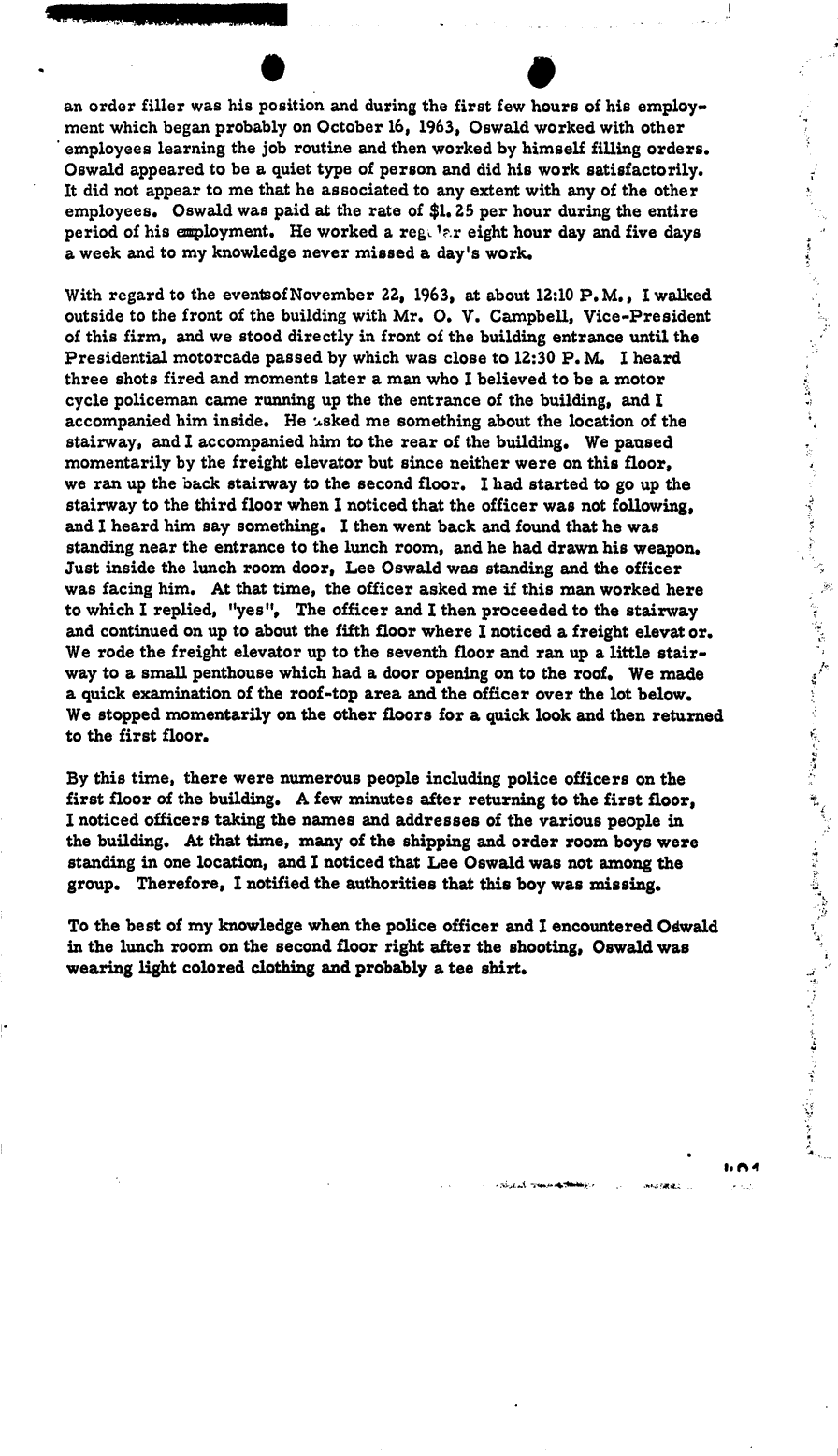
This document is available via a link in The Anatomy of the Second Floor Lunchroom Encounter.


Prayer Man is a Man
in JFK Assassination Debate
Posted · Edited by Andrej Stancak
To follow up with Prayer Man's body height analysis. I lifted the lowest (5'2'') yellow plane by half an inch so that it now aligns with the top of Prayer Man's head. The horizontal yellow line is at 5'2'' 1/2 and the line touches the lower aspect of Buell Wesley Frazier's chin, exactly as we see it in Darnell. I do not know how to make things better and more transparent than this, so I leave the plane issue by saying that the top point of Prayer Man's head was 5'2'' 1/2 above the plane of the top landing.
Of course, Prayer Man could not be so short. However, he stood one step below, on the second step, and therefore, it is necessary to add the height of one riser which was 7 1/8'' according to Bart Kamp's measurements. Thus, Prayer Man net height was 5'2'' 1/2 + 7 1/8'' = 5' 9'' 5/8.
This body height breaks down into 5'9'' which represents the body height of Lee Oswald without shoes and 5/8'' (1.6 cm) which accounts for the height of a shoe heel. I checked the height of heel in all my shoes and it varied between 1.5 cm and 2.5 cm. If someone has a trip to the NARA in the near future, can you please take measurements of Lee Oswald's shoes.